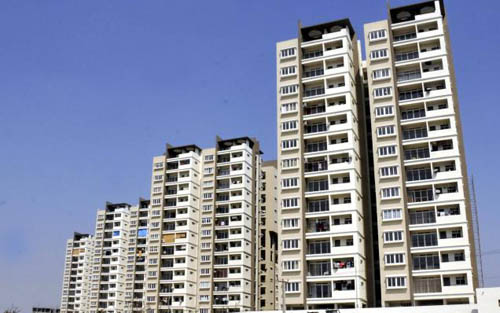
Commercial real estate: Key demand drivers in red-III
In India, investor interest is also seeing a slowdown on account of the lower absorption of new developments and the disparity between investment returns and capital values.

In India, investor interest is also seeing a slowdown on account of the lower absorption of new developments and the disparity between investment returns and capital values.

Foreign direct investment (FDI) in the real-estate sector last year was the lowest in four years, but private equity activity gained momentum during the recent months, according to a study by an Indian industry chamber and a global accountancy firm.

Prices of key materials like steel and aluminum have relatively stabilized in 2024. Rising construction cost has primarily been on account of labour cost surge, at about 25% YoY in the private sector. Volatilities in construction material prices and labour cost pressures are likely to push overall construction cost upward, albeit at a slower pace. Over the last one-year, average cost of construction is estimated to have risen up to 11%, mainly due to a significant surge in labour costs coupled with a moderate price increase in construction materials like sand, brick, glass, wood etc. Notably, the cumulative effect of rise in the prices of four key construction materials including cement, steel, copper and aluminum have been relatively low. In fact, average cement prices have seen a steep decline of 15%, while average steel prices have witnessed a ma

As the education sector evolves, factors such as technology permeation, revamped building designs, and focus on health & safety are likely to define education real estate. Besides, modern educational building design must prioritise flexibility so that spaces can be reconfigured to adapt to various teaching methods and activities, developing a dynamic learning environment. To address this and move away from traditional classroom setups, educational buildings now include collaborative spaces to encourage teamwork and group learning. Moreover, sustainable, and eco-friendly design elements, such as energy-efficient systems and natural lighting, are becoming increasingly common to reduce the environmental impact of educational buildings.

Ashiana Amodh in Talegaon, Pune, is designed to make it even more exciting. Well, connected to both Mumbai and Pune via the Mumbai-Pune Expressway, Ashiana Amodh offers a peaceful retreat amidst the natural beauty of green hills and the Indrayani River. With clean air, pleasant weather, and scenic views, it is an ideal destination for retirees seeking an active lifestyle in nature. Spread across 11.93 acres, Ashiana Amodh features 1/2/3 BHK premium residences and a 19,000 sq. ft. clubhouse with modern amenities like a yoga lawn, swing plaza, acupressure pathway, swimming pool with jacuzzi, gym, card room, music room, art & craft and reading room, ensuring seniors lead a vibrant, fulfilling life. The Senior Living Conclave 2024 highlighted the growing potential of senior living, and Ashiana Housing’s ongoing efforts are shaping a brighter future for the senior community.

Residential assets were the first preference for domestic investors during Q3 2024 whereas foreign investors accounted for 64% of the commercial deals. Growing prominence of work-from-office mandates and GCCs (global capability centres) lured foreign investors, leading to an increase in the share of commercial investments from 24% in Q3 2023 to 71% in Q3 2024. On the other hand, the share of residential sector reduced to 19% in Q3 2024 from 44% in the same period a year earlier. However, investment in residential assets is expected to grow in the coming quarters as niche asset classes such as co-living, senior housing, and serviced apartments are gaining traction.

The Indian economy continues to grow at a healthy pace, with the World Bank raising its growth forecast for India’s economy to 7% for FY 25, up from an earlier projection of 6.6%. The India Development Update (IDU) observes that India remained the fastest-growing major economy and grew rapidly at 8.2% in FY23-24. Growth was boosted by public infrastructure investment and an upswing in investments in real estate.

In a report ‘India Market Monitor Q3 2024 – Investments’, CBRE indicates a robust 46% Y-o-Y growth in real estate equity investments, totalling USD 8.9 billion in Jan-Sep ’24 —the highest-ever recorded since CY 2018, surpassing the USD 7.4 billion total equity investments for CY 2023. On a quarterly basis, equity investments in real estate stood at USD 2.6 bn in the Jul-Sep’24 period. Domestic investors (predominately developers) took the lead with ~79% share in equity capital inflows in Jul-Sep ‘24. Singapore-based investors accounted for nearly 73% of the total foreign capital inflows, followed by the United States (~22%). Developer activity picked pace in Jul- Sep ’24 quarter, accounting for a share of nearly 47% in total equity investments, followed by institutional & collective vehicle investors (~36%).

Q3 2024 attracted USD 1.1 Bn inflows, 45% higher over Q3 2023. Office segment drove over half of the investments in Q3 2024, followed by residential with 33% share. Domestic investments accounted for 44% of the total investments during the quarter. Chennai & Mumbai cumulatively attracted 57% of the inflows in Q3 2024. Sustained confidence in Indian economy continued to drive institutional investments into the real estate sector, reaching USD 4.7 billion during the first three quarters of 2024, almost at par with the corresponding period in 2023. Following significant inflows in the first two quarters, Q3 2024 too registered healthy investment inflow of about USD 1.1 billion, reflecting a 45% YoY growth.

In a report titled, ‘Fortifying India’s I&L landscape with a new manufacturing growth formula’, property consultant CBRE claims that the manufacturing sector’s growth has significantly contributed to warehousing demand. The share of sectors catering to the manufacturing space, including engineering & manufacturing, electronics & electricals and auto & ancillary sectors, within the total warehousing demand across major cities, has increased substantially, growing from 15% in 2019 to 24% in 2023 and 25% in H1 2024. The total leasing for warehousing from these manufacturing-related sectors stood at 4.1 mn. sq. ft. in H1 2024.
